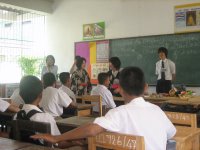
I just read the book Imperial Subjects As Global Citizens by Mark Lincicome. It describes the international education movement in Japan from 1910 to the 1990s. I read it after judging a speech contest in which junior high school students spoke in Japanese about their ideal kind of international exchange. The top 6 students in this contest would get to visit a junior high school in Canada as representatives of the city I live in. All the JHS students I heard speak were remarkably mature for their age and were able to articulate their thoughts enthusiastically and well. When I was a JHS student, I was not even close to their level of maturity nor would I have been capable of making such appealing speeches. Nevertheless, there was something about the speech contest bothered me but I was not sure what. The book had been sitting unread on my bookshelf for about a year and I finally decided to open it up and see if I could figure out what was bothering me.
In a nutshell, the book argues that throughout modern Japanese history, there has been conflicting purposes in international education. One purpose of international education has been to bring up creative, compassionate and independent thinking students who can contribute to world peace. On the other hand, another purpose has been to bring up patriotic students who will respect their country and share Japan's wonderful culture with the rest of the world.
Of course, I think that there is a lot to like about Japan. If I did not think so, I would not be here. Every year, I help run a program that brings students in the English Education Department at my university to high schools in Thailand for for a two week teaching internship. At these schools, the intern teach Thai students about various aspects of Japan. In the past, we have done such topics as seasonal events, high school life, ghost stories, origami, toys, and Iwate's history of tsunami. Usually after the teacher trainees have finished their classes, the Thai students have a very positive image of Japan. Now, before I go any further, please don't get me wrong, I am happy that the Thai students have a positive image of Japan, they should.
Nevertheless, every country has history which they regret. Japan's colonization of Manchuria as well as the Korean peninsula and the human rights violations accompanying this would most likely fall in this category. This history is a big contributor to the resentment that many Chinese and Koreans have towards Japan and definitely affects relations between these countries. I think that this resentment makes disputes over the
Senkaku Islands with China and
Takeshima Island with Korea that much more difficult to resolve.
In the speech contest I judged, most of the students talked about aspects of regional culture or Japanese culture that they wanted to show the Canadian students. Few talked about what they wanted to learn in Canada or what they knew about the place they would be visiting. It seems to me that a lot of what is emphasized in "international understanding" is showing positive aspects about Japanese culture to non-Japanese. Furthermore, it seems that the image of "non-Japanese" that many students have are anglo westerners. Nevertheless, the largest foreign populations in Japan are China and Korea, respectively.
An important part of understanding other people is to try to look at things from their perspective and learn from it. In my daily life here (I cannot speak about Japan as a whole), this seems to be missing. In Thailand, in addition to having the Japanese teachers teach about Japanese culture, we need to ensure that there is a component where the Thai students teach us about their daily lives and customs. Of course, giving students these kinds of experiences won't immediately solve tensions between Japan and its neighbors. Nevertheless I think that it could be a start.







